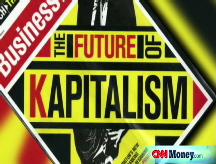Recession fears stall credit
Banks maintain a tight grip on money, as fears that the global economy is entering a prolonged recession spook lenders.
NEW YORK (CNNMoney.com) -- The recent trend of loosening credit stalled Thursday as lenders took a breather, a day after dismal corporate results renewed fears of a global recession.
The overnight Libor rate edged up to 1.21% from 1.12% Wednesday, according to Bloomberg.com. Libor is a daily average of what 16 different banks charge other banks to lend money in London and is used to calculate adjustable rate mortgages. The higher the rate, the tougher it could be for homeowners to repay those mortgages.
However, the overnight bank lending rate had been steadily declining over the past eight business days and still remains below the rate that federal banks charge other banks - positive signs for the credit markets. The federal funds rate stands at 1.5%.
"This is probably just a one or two day reprieve," said Andrew Brenner, senior vice president of MF Global. "It's a tough market, and people don't want to go down too far, too fast."
Overnight Libor spiked as high as 6.88% after the Treasury's $700 billion bailout bill was signed into law on Oct. 3.
Longer-term lending remained tight with the 3-month Libor holding steady at 3.54%, according to Bloomberg. Last week, the 3-month rate surged to 4.82% - the highest since mid-December 2007. By comparison, it was under 3% about a month ago.
"It's a reaction to stocks, which are down because we're going into a recession or steep economic downturn," said Brenner. "But 3-month rates should continue to grind about 100 basis points (1 percentage point) lower."
For the past two weeks, central banks around the globe have lowered interest rates and directly injected capital into the banking system. That has encouraged banks to issue more loans and make them cheaper.
"The governments' actions will start to free things up, but what we really need is an upturn in the housing market," Brenner said. "That would give confidence to all the other markets."
In testimony before the Senate Banking Committee Thursday, Sheila Bair, chairwoman of the Federal Deposit Insurance Corp., said her agency and the Treasury Department are working closely to find ways to prevent avoidable foreclosures, including loan guarantees to mortgage lenders.
Confidence boost: Two key indicators of risk sentiment showed more cracks in the frozen credit ice and that bodes well for borrowers.
The "TED spread" rose slightly to 2.56 percentage points from 2.53 points Wednesday. The TED spread measures the difference between the 3-month Libor and the 3-month Treasury bill, and is a key indicator of risk.
The higher the spread, the more unwilling investors are to take risks. The spread was 1.04 percentage points just a month ago and reached a record high of 4.65 points a little more than a week ago.
Another indicator, the Libor-OIS spread, edged slightly lower, to 2.51 percentage points from 2.53 points Wednesday.
The Libor-OIS spread measures how much cash is available for lending between banks, and is used for determining lending rates. The bigger the spread, the less cash is available for lending.
Commercial paper shrinks: As the stranglehold on credit remained tight, a key form of lending to major businesses and banks contracted for the sixth week in a row, according to a weekly report from the Federal Reserve released Thursday.
Total commercial paper outstanding shrunk by $61.5 billion, or 4.1%, to a seasonally adjusted $1.45 trillion in the week ended Oct. 22. It was the lowest level that measure has seen in more than three years.
Cmpanies issue short term loans to fund day-to-day business operations but the market has dried up as confidence on Wall Street has waned.
Treasurys signal optimism: Government debt prices were mixed Thursday, as stocks edged down in afternoon trading, and recession fears led to the expectation of more rate cuts.
According to the Chicago Board of Trade, investors now believe there is an 80% chance that the Federal Reserve will cut its key funds rate by as much as a half of a percentage point to stimulate the economy when it meets Oct. 28-29.
The U.S. central bank uses its rate-cutting tool to encourage lending in an attempt to boost the economy. However, rate cuts tend to be inflationary, and bond investors worry that their assets will devalue over time as the dollar sinks.
The 2-year note, which fluctuates the most on rate changes, fell 2/32 to 100-19/32, and its yield rose to 1.55% from 1.51% late Wednesday. Investors tend to flock to Treasurys in times of economic uncertainty because the safety of lower returns offsets the risks of more lucrative equities.
The yield on the 3-month bill fell to 0.96%, down from 1.01% on Wednesday.
The yield on the 3-month Treasury bill is closely watched as an immediate reading on investor confidence. Investors and money-market funds shuffle funds into and out of the 3-month bill frequently, as they assess risk in the rest of the marketplace. A higher yield indicates that investors are slightly more optimistic.
But the benchmark 10-year note rose 8/32 to 103 18/12, and its yield fell to 3.57% from 3.60% late Wednesday. Bond prices and yields move in opposite directions.
The 30-year bond climbed 1-8/32 to 108 27/32, and the yield sank to 3.99% from 4.06%. It was the first time the yield slipped below 4% since Oct. 6. ![]()



